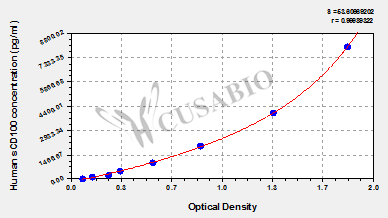This human soluble cluster of differentiation 100 (sCD100) ELISA kit employs the quantitative sandwich enzyme immunoassay technique to measure the levels of human sCD100 in different samples, including serum, plasma, or tissue homogenates. The enzyme-substrate chromogenic reaction is also used to amplify the signal and quantify the levels of the analyte through the intensity of the colored product. The color intensity positively correlates with the amount of sCD100 bound in the initial step.
CD100, also known as SEMA4D, plays a major role in the nervous and immune systems. SEMA4D has been shown to use two distinct receptors, plexin-B1 in the nervous system and CD72 in the immune system. SEMA4D is expressed at high levels in various tumor tissues, including head and neck squamous cell carcinoma, prostate cancer, and colon cancer. SEMA4D and its receptor Plexin-B1 are commonly dysregulated in cancers, suggesting roles in cancer progression, invasion, tumor angiogenesis, and skeletal metastasis.






